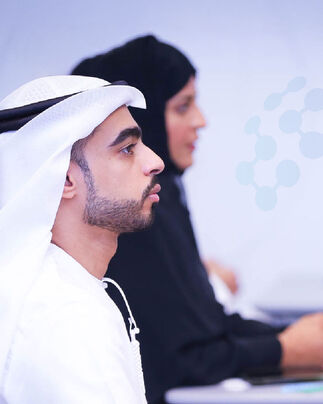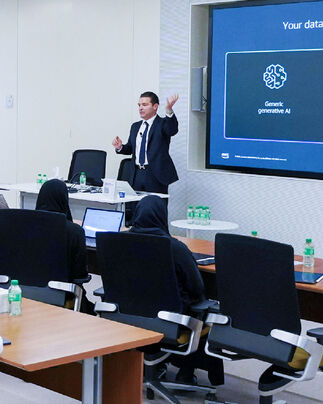As the world's first graduate-level, research-based artificial intelligence (AI) university, Mohamed bin Zayed University of Artificial Intelligence (MBZUAI) is continuing to increase the breadth and pace of publication of ground-breaking research in artificial intelligence (AI).
Between January to June 2024, the MBZUAI community of more than 80 faculty, in excess of 200 researchers, and hundreds of students, has published more than 300 papers at top-tier AI venues. This included 39 papers at the International Conference on Learning Representations 2024 (ICLR) in May.
This follows the success of 612 published papers delivered at top tier venues in 2023. Highlights included delivering 30 papers at the International Conference on Computer Vision (ICCV), 34 papers at the IEEE/CVF Computer Vision and Pattern Recognition Conference (CVPR), 44 papers at Empirical Methods in Natural Language Processing (EMNLP), and 53 papers at the Conference on Neural Information Processing Systems (NeurIPS).
In the five years since its inception, MBZUAI has achieved recognition as one of the world’s top 100 universities in the field of computer science, and is ranked in the top 20 globally across AI, computer vision, machine learning, natural language processing (NLP), and robotics (CSRankings).
Five research papers published by MBZUAI in the past six months cover diverse topics with real-world applications and impact.
A team of MBZUAI researchers, working with international collaborators, has developed a series of resources for identifying text created by large language models (LLMs), which could have a profound impact in fields such as journalism, academia, and education. Previous research in this field was limited to reviewing only one or two languages, using only one text generator, or considering only single domains, such as news, or uses, such as summarisation of text. The M4 analyser that came out of this work covers multiple languages, various LLMs, and diverse domains, to enable more general machine-generated text detection. Additionally, the dataset associated with this work will lay the foundation for future research on more robust approaches to the pressing societal problems associated with LLM-created text.
The paper, M4: Multi-generator, multi-domain, and multi-lingual black-box machine-generated text detection, was awarded the Best Resource Paper Award at the European Chapter of the Association for Computational Linguistics Conference 2024 (EACL) held in March. MBZUAI Professor of Machine Learning, Acting Chair of Machine Learning, and Director of Center for Integrative Artificial Intelligence (CIAI), Professor Kun Zhang, has collaborated with his PhD student Gongxu Luo and researchers from major American universities to create a model that enhances the accuracy and analysis of gene-sequencing processes. Their research could help to improve understanding of a range of diseases, and potentially improve treatments and outcomes.
Gene regulatory networks (GRNs) represent the causal relationships governing gene activities in cells that are vital for understanding biological processes and diseases. A common problem in investigating GRNs are dropouts, or zero values, in single-cell RNA sequencing data. These zero values could be true dropouts, reflecting no gene activity, or false dropouts caused by the sequencing process itself. In the paper, Gene Regulatory Network Inference In The Presence Of Dropouts: A Causal View, the researchers propose a new causal dropout model that provides a more accurate picture by focusing on data without zeros when testing gene relationships.
The paper was presented at ICLR and marked a significant step forward in genetic research. One of MBZUAI’s first PhD graduates, William de Vazelhes, has collaborated with MBZUAI faculty and a fellow PhD student to develop an algorithm that promises to enhance the training efficiency of models that rely on hard-thresholding, as commonly used in statistics and data science. In the paper, New Insight of Variance reduce in Zero-Order Hard-Thresholding: Mitigating Gradient Error and Expansivity Contradictions, he proposed a new approach that reduces errors in model training by managing variance better, leading to faster and more reliable results. Tests on financial portfolios and cybersecurity challenges show the algorithm's promise.
The paper was published at ICLR 2024.
Researchers from MBZUAI have led a global team in developing an advanced vision language model called Grounding Large Multimodal Model (GLaMM), which supports higher-fidelity interaction between text and images. It is capable of generating natural language responses related to objects in an image at the pixel-level, offering enhanced automated image captioning, reasoning, and the ability to switch objects in images.
In their paper, GLaMM: Pixel grounding large multimodal model, the researchers detail how the model is trained to allow users to interact using both text and visual prompts, generating natural language responses seamlessly intertwined with corresponding object segmentation masks. To test GLaMM, the authors created a novel dataset with millions of detailed image annotations. GLaMM's advanced capabilities make AI more intuitive and effective in tasks like grounded conversation generation, referring expression segmentation, image and region-level captioning, and vision-language conversations.
Real-world applications include sectors such as e-commerce, fashion, smart cities, public safety, and home retail. GLaMM was published at CVPR 2024 in Seattle, the highest-ranked engineering and computer science venue worldwide. It has already received more than 50 citations and 600 stars on GitHub.
Dr Xiaodan Liang and Professor Xiaojun Chang, both MBZUAI professors from the Computer Vision Department, have teamed up with international collaborators to develop a new technique that can make vision transformers, a core component of most modern models for image and video analysis, more efficient. As set out in their paper, MLP can be a good Transformer Learner, the key discovery is that certain layers in the transformer can be replaced with much simpler multilayer perceptron (MLP) layers. This change, guided by a measure of randomness known as entropy, helps maintain model performance with much smaller models. The new method supports more streamlined and efficient AI model training, potentially paving the way for faster and less resource-intensive technologies.









